The New JSB Hades .22 Caliber Frangible Hunting Pellet…
It took some doing, but I was able to acquire a tin of the new JSB Hades pellets pre-release. YAAAAAAAY! If you’re familiar with my ALL THINGS AIRGUN Youtube channel, then you know pellet testing is one of my favorite things to do. I was absolutely thrilled to get my hands on these pellets, and thank Predator Pellets for providing them. I apologize that it’s taken until now to get my results published. The video below accompanies this blog, and I recommend watching it as well as reading this.
The Hades pellets are marketed as a frangible hunting pellet. They have what looks like a radiation warning symbol molded into their head as a cavity. One of the best things about these pellets is that they’ll fit nearly every .22 magazine on the market. They’ve been released as of a couple weeks ago, but only in .22 caliber for the time being. You can find them right now on our website. If you’re not familiar with the term, “frangible” more or less means “fragile, and intended to break apart.” Will they actually do that? Will they really break apart inside an animal causing devastating wounds that will kill game quickly and efficiently? We’ll get to that, but first….the boring stuff.
I am a pellet sorter of the highest order. Thus, I have tons of equipment to accurately measure most properties of a pellet. This includes my highly accurate diamond scale, and multiple gauges from Pelletgage…among other things. While I wish I did, I just didn’t have the time to sort and measure the entire tin of 500 pellets. I took a random sample of 50 pellets, and measured them for both headsize and weight.
Out of my sample of 50 pellets, 48 measured 5.50mm headsize and 2 measured 5.49mm headsize. This is very consistent, and far better than many lesser quality hunting pellets I’ve measured. The weight of the pellets was less consistent, however. My extreme spread was nearly a whole grain, from 15.45gr – 16.35gr. As you can see in the graph below, there’s a very distinct large grouping of like pellets between 15.90 and 16.2 grains. There’s also a lesser grouping around the 15.50gr area. This isn’t the worst weight spread I’ve ever seen, but I’ve seen better.

So what does this mean for accuracy? In short, the Hades is an EXTREMELY accurate pellet. I don’t just mean among hunting pellets, but among all pellets. I used a Daystate Wolverine R .22 for all of my testing. Using that Wolverine, an Aztec Emerald 3-18×50, and the Hades pellets (unsorted, straight from the tin)…I shot a 247/250 at our Baker Airguns “In-Store” Benchrest competition. That score easily won the competition this month, and is in line with my scores using good old JSB Exact Jumbo 15.89gr pellets from the same gun. That is very accurate.
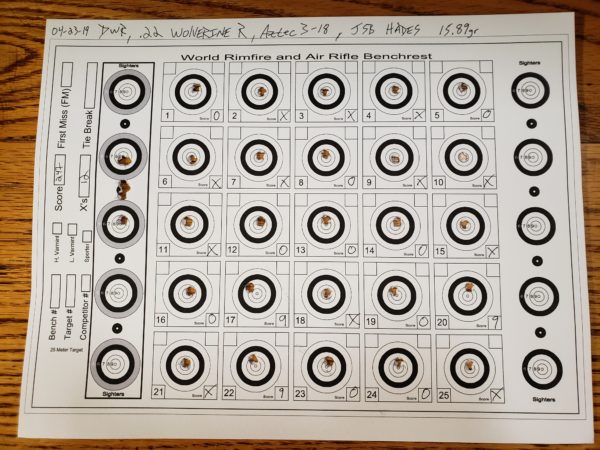
Out at 50 yards, the Hades again did very well. I mean sub-MOA good, and in unfavorable wind conditions. The average wind I faced was about 5mph steady with every bit of 15mph gusts in random directions. Those gusts were the killer. I tried to take shots during periods without gusts, but we all know that is not an exact science. Even still, if you discount one flyer that was either my fault or a wind gust, my average Center-to-Center measurement from three 5-shot groups was 0.42″. For an expanding hunting pellet, unsorted and straight from the tin, that is exceptional. The best group was 0.357″, and the worst was 0.503″. Without question, the Hades in .22 caliber (shot from a gun that’s powerful enough and likes them) is accurate enough for taking shots at game at 50yds and beyond.
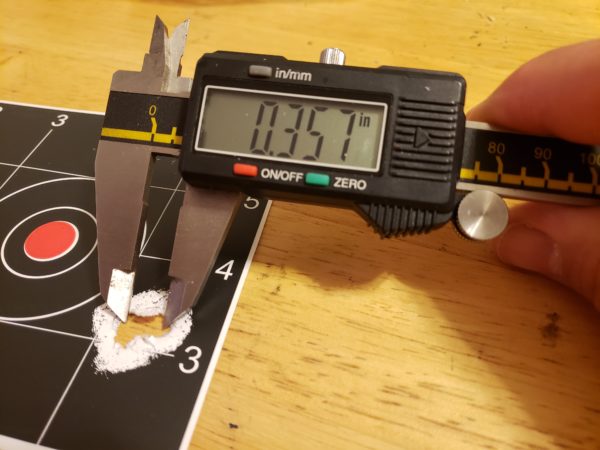
Now onto the fun part where we shoot things with the Hades to see what happens. All test shots were taken at a distance of 20 yards using the Daystate Wolverine R. The average velocity was about 915fps producing right around 30 foot-pounds of muzzle energy. At 20 yards, the target is receiving a little over 24 foot-pounds of energy. This should replicate a realistic hunting shot with common energy levels. In fact, as you’ll see later, this was a very likely approximation.
We at Baker Airguns are going to use a new testing medium that is as close to shooting a real animal that we are willing to publish. It’s so close to shooting a real animal…that IT IS shooting a real animal. Do not despair. I will not be harming any innocent creatures, nor provide anything bloody and gory for your viewing pleasure. We have a new pellet testing medium, and his name is Mr. Leghorn. Mr. Leghorn is a raw, store-bought roasting chicken that is covered with a single layer of mink-hide. This is as close as we’re going to get to shooting a live animal for pellet testing productions. The meat is real meat, the bone is real bone, and the hide is real hide. This should fairly accurately simulate a body-shot on most appropriate airgun quarry like a squirrel, raccoon, groundhog, or rabbit.
The results of the Mr. Leghorn test are very revealing. I shot the target 5 times, and recovered 3 pellets. One was a complete pass through, and one apparently went into a black hole…as we cannot find it. Of the three recovered, one was stopped by the plastic on the far side of the chicken, and the other two about an inch short of that. All pellets started out at 0.22″ and right at 16.0gr. The average expanded diameter of the three recovered pellets was 0.267″. The largest was 0.271″. The retained weight of the three pellets was 13.95gr, 15.35gr, and 16.05gr. Clearly, two of the three pellets DID fragment and shed weight to some degree. So is the JSB Hades really a frangible pellet? Our testing says yes, when shot into flesh, it does tend to deform, expand, and shed mass as advertised. What they will not do, however, is leave the enormous craters in flesh that you see when these pellets are shot into clay or soap or ballistics gel. Our wound tracks were almost exactly the diameter of the expanded pellets…and nothing more. As with any sub-sonic projectile…they are not capable of producing “hydrostatic shock.” That phenomenon revolves around a supersonic shockwave, which a subsonic projectile is completely incapable of producing. Therefore, there was no bruising or damage to the flesh surrounding our roughly 1/4″ wound channels.
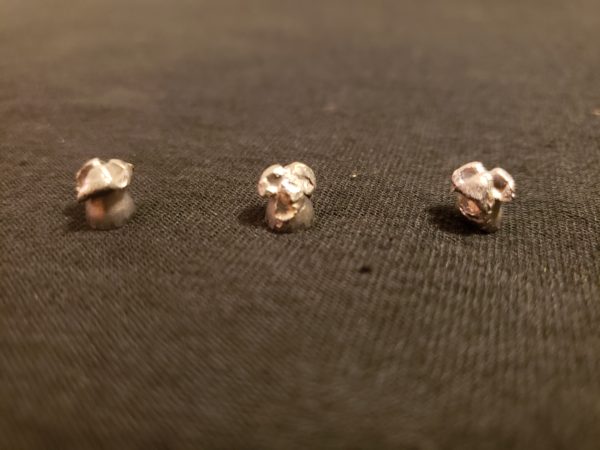
Now, I know what you’re thinking. You’re thinking that there’s some problem with that test and that I should have used clay or ballistics gel or something to test these pellets….and you’re wrong. The Mr. Leghorn test is THE BEST representation of what happens to a pellet in a living breathing animal that we’ve ever seen. We know this because we also happen to have two recovered pellets from shooting a real living breathing groundhog at exactly 20 yards….the same distance Mr. Leghorn was shot from….from the same gun. The average expanded diameter of the two recovered projectiles was 0.254″, with retained weights of 15.85gr and 16.30gr. The retained weights are a bit misleading, as there was some flesh and fur that I could not remove from the pellets. They seemed to fragment slightly the same as the ones shot into the chicken. As you can see, the pellets shot into the chicken are very much similar to the ones recovered from a living breathing animal. I have great confidence in the efficacy of our new Mr. Leghorn testing medium.
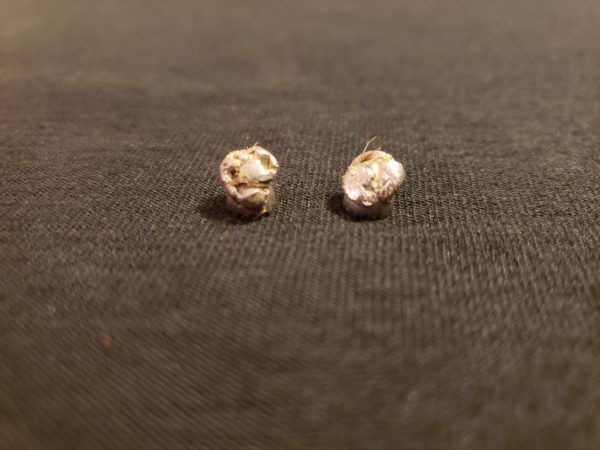
As a side note, some of these pellets were used to de-bird an area. These were harmful and invasive birds that are classified as pests. Our shots were only taken at small birds from about 10 yards from the 30fpe Wolverine…but WOW! I mean….WOW! I promised not to show you any bloody, gory stuff…but I must describe it a bit. I am not exaggerating in the least when I say that most of the birds that were shot center mass, as opposed to in the head, were nearly torn in half! Granted, these were small birds at close range from a 30fpe gun…but WOW! Just….WOW! I would not use these pellets on any small birds that you intend to eat. There won’t be much left.
So what can we learn from all of this? Well, we’ve learned that the Hades is capable of nearly match-grade accuracy when shot from a gun that agrees with them. We’ve learned that they are very likely to expand when given enough energy, and that the effect of this expansion is quite devastating to small game. Another thing we’ll learn, that I’ve not mentioned yet, is that this level of performance does not come cheap. A tin of 500 JSB Hades will set you back about $21.99 plus shipping. This is about $3 more than the venerable JSB Exact Jumbo 15.89 500ct, but still less than what it would cost for 500 Polymags. In my opinion, the performance of the Hades is well worth the cost. In fact, I’m going to start using these in some of my rifles. That is the highest praise that I can give a product. Well done, JSB/Predator Pellets. Well done.
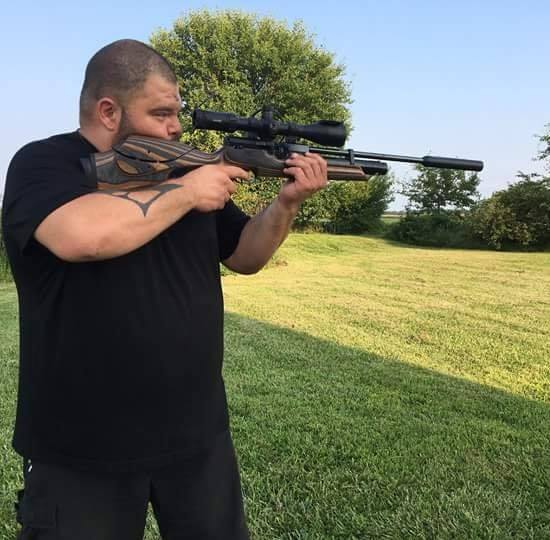
Donnie Reed is our Sales Manager and general airgun guru here at Baker Airguns. He was a member of the U.S. Marine Corps, and qualified as both a Rifle Expert and Pistol Expert. Donnie is now a competitive airgun shooter, focusing primarily on field target and benchrest competitions. He has won both PCP and piston class field target matches, as well as local benchrest competitions. Donnie also runs the Youtube channel and Facebook group ALL THINGS AIRGUN. His first college degree is in Mathematics and Sciences, but he is still pursuing another in Physics and Astronomy.

